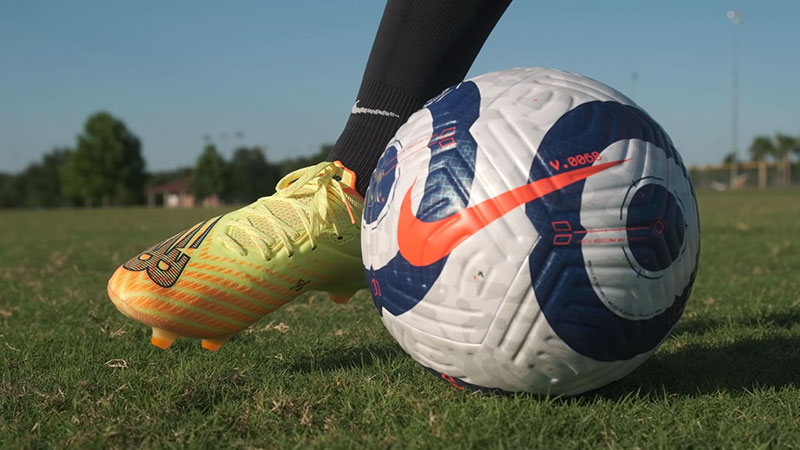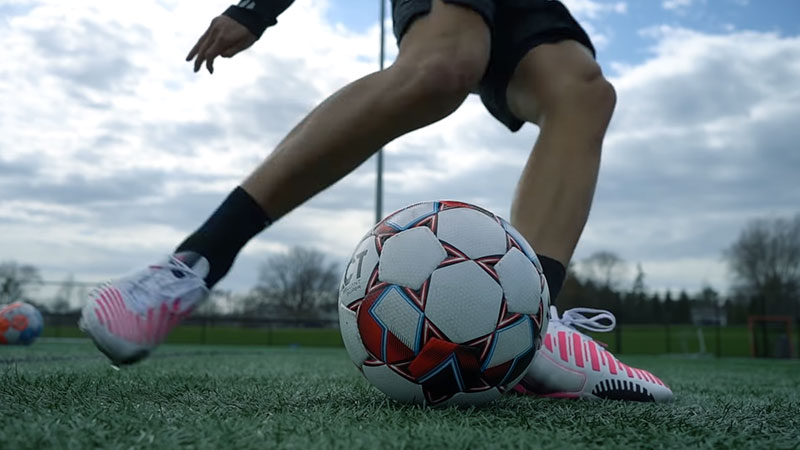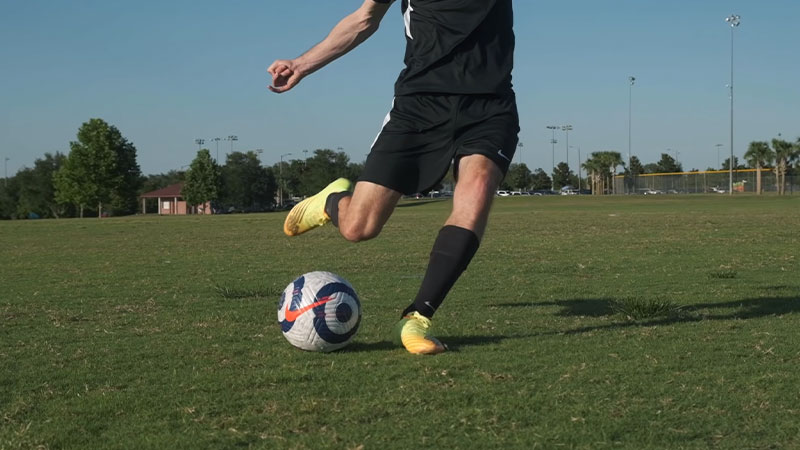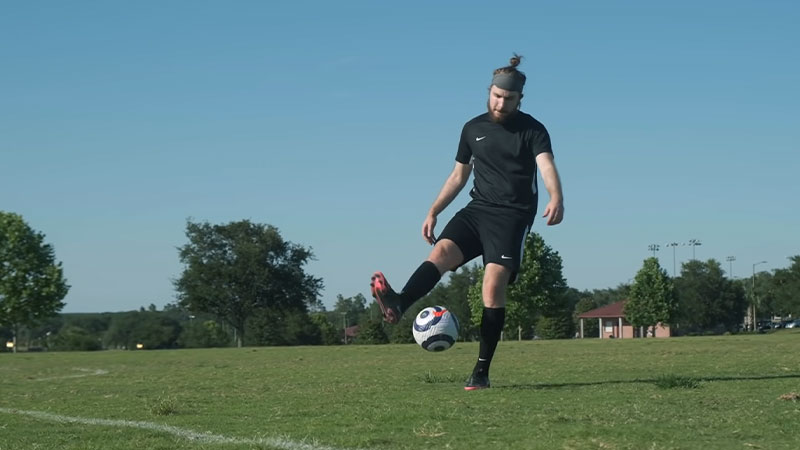Have you ever wondered how soccer players manage to make the ball swerve in mid-air during a match? The curve in football, also known as the ‘banana shot’ or ‘bending the ball,’ is what you’re witnessing.
Simply put, it’s a technique that causes the ball to follow a curved trajectory rather than a straight line. This can be particularly useful for maneuvering around obstacles or tricking opponents.
Players use a combination of skill, precision, and an understanding of physics to pull off this impressive move.
They strike the side of the ball with their foot at an angle, applying spin, which results in its curving path. It’s not something that comes naturally – it takes practice and finesse.
So, you’ll know exactly what’s happening next time you watch your favorite team and notice that incredible bending shot on goal.
The curve in football isn’t just about showmanship – it’s about outsmarting opponents and creating opportunities where there might be none. An intricate element makes football an engaging sport to watch and play.
Understanding the Curve in Football

Have you ever wondered how footballers bend the ball in mid-air? You’ve seen it on TV or maybe even live at a game.
It’s an impressive sight when a player sends the ball spinning around defenders and straight into goal. That’s what we call “the curve” in football, and it’s not magic. It’s science!
The curve is all about technique and physics. Players strike the ball off-center and create a spinning motion that influences its trajectory.
This technique, known as the “Magnus effect,” was named after Gustav Magnus, who first explained this phenomenon in 1852.
When players kick the soccer ball on one side with their instep, they cause it to spin during flight.
As air pressure differs on both sides of the spinning ball (low pressure on one side and high pressure on the other due to faster-moving air), it causes the ball to curve mid-air!
Here are some key factors that influence how much a football will curve:
- Amount of spin: A higher rate of spin generates more curves.
- Speed of kick: Faster kicks take less time for air pressure differences to affect the trajectory. Thus, there is less curve.
- Ball design: Modern balls often have fewer panels and smoother surfaces, enhancing their ability to fly true.
Mastering this skill takes practice. Some players even spend years perfecting their curving kicks! So next time you see someone bending a shot around defenders or making those impressive corner goals, remember – there’s more going on than meets the eye!
Physics Behind a Soccer Ball’s Curve

When I kick a soccer ball, I’m not just sending it into motion. An intricate physics dance is at play, orchestrating the ball’s path and speed. Understanding this can elevate your game.
Let’s start with the most obvious factor: force. When I strike the ball off-center, it creates a spinning motion. This is what we call “spin”. The more spin, the greater the curve you’ll see in flight.
But why does spin cause a curve? The answer lies in something called the Magnus effect. This is where things get interesting!
- Named after physicist Heinrich Gustav Magnus, this effect explains how air pressure around a spinning object (like our soccer ball) influences its trajectory.
- As the ball spins through the air, it drags some air molecules.
- There is higher pressure on one side of the ball (the side moving against airflow) because these air molecules get compressed.
- Conversely, there’s less pressure on the other side (moving with airflow) as these molecules are spread out. The difference in pressure causes an imbalance that pushes or ‘curves’ the ball in one direction.
Now let us delve into Bernoulli’s principle, which also plays a part here:
| Side of Ball | Air Speed | Pressure |
|---|---|---|
| Against Flow | Slower | Higher |
| With Flow | Faster | Lower |
This principle states that as fluid speed increases, its internal pressure decreases. Since faster-moving air equates to lower pressure (and slower to higher), another layer of complexity is added to our football curve!
So next time you’re watching or playing football and marveling at those tricky curving kicks – remember, it’s all about physics!
How to Master the Art of Curving a Football?

Mastering the art of curving a football is an endeavor that blends science with skill and finesse with precision.
It’s a pursuit that rewards dedication and understanding, and with the proper techniques, anyone can learn to bend it like Beckham.
Understand the Magnus Effect
To truly master the curve, one must first comprehend its science. The Magnus effect is the key here.
It’s the phenomenon that occurs when a spinning object, like a football, creates a difference in air pressure around it, causing it to curve in flight. Knowing this principle allows you to manipulate the ball’s trajectory intentionally.
Perfect Kicking Technique
The kicking technique is the foundation of any excellent curve shot. Focus on striking the ball slightly off-center, using the inside part of your foot near the big toe.
This ensures precision and control over the direction of the spin. Additionally, your approach matters. Position yourself about four steps back and two steps over from your target, setting yourself up for the perfect angle of attack.
Crucial Timing
Timing is everything when it comes to executing a curve shot. It’s about how hard you kick the ball and when you make contact.
Aim to strike the ball just after the bottom center at an angle that allows for optimal spin. This timing and proper force will produce the desired curve as the ball sails through the air.
Practice till Perfection
Like any skill worth mastering, curving a football takes practice a lot of it. Repetition is critical to ingraining the techniques into muscle memory and consistently honing your ability to precisely execute curve shots.
Set aside dedicated practice sessions to focus on perfecting your technique and experimenting with different angles and spins until you find what works best for you.
Impact of the Curve on Game Strategy

I can’t emphasize enough how much a good curve can revolutionize a football game’s strategy. It’s not just about scoring goals from free kicks or corners; it also significantly affects gameplay, tactics, and player positioning.
Here’s a concise summary of the impact of the curve on game strategy
Deceptive Trajectories with Long Passes
Curving long passes introduces unpredictability, making it challenging for defenders to anticipate the ball’s path. This strategic approach allows for the creation of scoring opportunities by exploiting spaces left vulnerable by confused defenders.
Reduced Reaction Time for Keepers with Curved Free-Kicks
Curved free-kicks present a formidable challenge for goalkeepers as the ball’s curved trajectory reduces their reaction time. This tactical advantage for the attacking side can lead to goals by catching keepers off-guard, altering the game’s momentum.
Own Goals from Swinging Crosses
Swinging crosses from corner kicks, delivered with curves, force defenders into awkward positions, increasing the likelihood of their own goals as they attempt to clear the ball.
The curvature of the ball disrupts defensive formations, creating chaos in the penalty area and offering scoring opportunities for the attacking team.
Curves in Defensive Distribution Strategies
Curves are not limited to attacking strategies; they also play a crucial role in defensive distribution tactics.
Goalkeepers utilize curves when kicking or throwing the ball to teammates, while defenders employ curved passes to evade pressing opponents and maintain possession, contributing to the team’s overall defensive strategy.
FAQ
Can the curve of a football be affected by external factors such as wind or weather conditions?
Yes, external factors like wind speed and direction, humidity, and air density can influence the trajectory of a curved football. Players must often adjust their technique and aim to compensate for these variables.
Are there specific training drills or exercises to improve one’s ability to curve a football?
Yes, there are various drills designed to enhance curve shot proficiency. These include practicing free kicks from different angles, using target cones to improve accuracy, and incorporating resistance bands to strengthen kicking muscles.
Can the type of football used affect the ability to curve the ball?
Yes, the construction and material of the football can impact its aerodynamic properties, affecting how it responds to spin and curvature. Players may find that certain brands or models of football are more conducive to achieving desired curve trajectories.
Are there any risks associated with attempting to curve a football during gameplay?
While curving the ball can be practical, risks include over-curving and sending the ball off-target or losing control. Additionally, improper technique or excessive force could lead to injury, particularly to the foot or leg.
Can players with different footedness (left-footed vs. right-footed) achieve the same level of proficiency in curving a football?
Yes, players of any footedness can master the art of curving a football with practice and dedication. While slight variations in technique may be based on the dominant foot, the principles of spin, precision, and timing remain consistent.
Final Thoughts on Football’s Signature Curve
Understanding the physics behind football’s curve unveils its beauty as a blend of science and skill. Mastery demands precision, practice, and strategic application.
From free kicks to open play, the curve is a potent weapon, dazzling fans worldwide. It’s more than scoring; it’s artistry on the pitch.
Each curved shot, a testament to dedication and knowledge, epitomizes the essence of ‘The Beautiful Game.’
So, as you watch or play, appreciate the finesse, the strategy, and the sheer brilliance behind every curve. Football’s signature arc enriches the sport, making every goal a masterpiece and every match an unforgettable spectacle of skill and passion.







